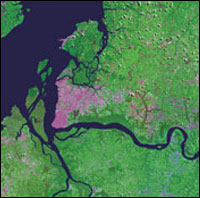
An image of the city of Belém taken with the Brazilian-Chinese CBERS-2 satellite. (Courtesy: INPE)
By Matin Durrani in São José dos Campos, Brazil
Two people died today in Brazil when a crane fell into the roof of a sports stadium in São Paulo that was due to host the opening ceremony of next year’s football World Cup.
The incident was not perhaps the best indication of Brazil’s technological know-how in a country that is keen to show its best face off to the world. But I saw a better example of Brazilian expertise today at the National Institute of Space Science (INPE) in São José dos Campos – a city of about 700,000 people 100 km north-east of São Paulo.
My visit to the INPE was hosted by Elbert Macau (whose middle name is Einstein, by the way), where my colleague Susan Curtis and I saw two key activities at the institute.
The first actitivy can be found in the giant experimental hall where Brazil puts its satellites through their paces before being launched into space. Researchers and engineers can test everything that a satellite might need to cope with, including extreme vibration, the immense noises on take-off, the vacuum conditions of outerspace and the electromagnetic fields that might send its electronics into a tail-spin. As Macau explained, the INPE has recently completed building and testing the country’s latest satellite, dubbed the China-Brazil Earth-Resources Satellite (CBERS-3), which was transported last month to China, where it is set to blast off in December.
The experimental facilities are also used by Brazilian industry – for example, to test whether the radiation emitted by mobile phones made in the country lie within legal limits for human safety. We even saw a giant Mercedes lorry in a huge house-sized “anechoic chamber” being tested to see if its electronics survive big electromagnetic fields.
Meanwhile, after lunch we saw the exciting effforts at the EMBRACE space-weather information and prediction centre. Brazil is unusual in that for many years it lay right underneath the South Atlantic Anomaly – a region where the Earth’s magnetic field is unexpectedly weak, which causes an increased flux of energetic particles that could expose satellites to unusually high levels of radiation. The anomaly used to be slap-bang over Brazil but has now shifted to over Paraguay. Still, Brazil wants to monitor the anomaly as it can play havoc with the country’s satellites.
Keep an eye out for more on the centre’s work in the Physics World special report on physics in Brazil, due out in April. I can’t help but think: if only the country put as much care and attention into building its football stadia as it does into space science.
Accidents like the falling of a crane on houses or elsewhere, unfortunately, sometime happens everywhere, but this should not be taken to point out negatively on the level and quality of “scientific development” of a country.